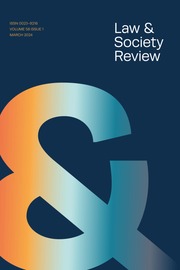No CrossRef data available.
Article contents
Enforcement agencies and an emerging category of law: examining EEOC processing of sexual orientation and gender identity charges
Published online by Cambridge University Press: 14 November 2024
Abstract
Scholars have recognized the role that legal intermediaries can play in shaping the law through their interpretations of legal ambiguity and guidance to rule-takers on legal compliance. Although legal intermediaries thus have the potential to effect social change, most research in the area of employment discrimination has focused on the way they facilitate only symbolic compliance with the law. In this article, we examine how the Equal Employment Opportunity Commission (“EEOC”) took steps that legitimized a new area of claiming, classifying sexual orientation and gender identity (“SOGI”) discrimination as prohibited sex discrimination. Drawing on 2012–2016 confidential charge data, we analyze which alleged issues had a greater likelihood of being identified by EEOC actors as strong cases of discrimination. We use quantitative administrative data and a unique dataset generated from the coding of charge narratives to develop our description of the EEOC’s categorization of SOGI charges. Our findings indicate that first by accepting SOGI charges and then by assigning 34% – much higher than other discrimination charge bases – with the highest processing category, the EEOC made new law, expanding Title VII protection. At the same time, our findings reflect that the EEOC exhibited restraint in this expansion through prioritizing charges that were closely aligned to prior gender stereotyping cases, rather than more directly signaling an SOGI identity-based protection. These findings illustrate the exercise of initiative within prior legal constraint, defining a new area of legal claiming.
Keywords
- Type
- Article
- Information
- Copyright
- © The Author(s), 2024. Published by Cambridge University Press on behalf of Law and Society Association.



